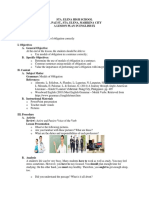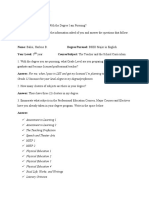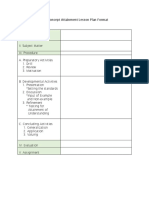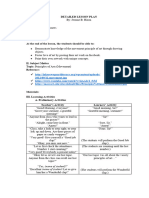Teachers' Activity Students' Activity A. Preparatory Activity
Teachers' Activity Students' Activity A. Preparatory Activity
Uploaded by
JJ Delegero BergadoCopyright:
Available Formats
Teachers' Activity Students' Activity A. Preparatory Activity
Teachers' Activity Students' Activity A. Preparatory Activity
Uploaded by
JJ Delegero BergadoOriginal Title
Copyright
Available Formats
Share this document
Did you find this document useful?
Is this content inappropriate?
Copyright:
Available Formats
Teachers' Activity Students' Activity A. Preparatory Activity
Teachers' Activity Students' Activity A. Preparatory Activity
Uploaded by
JJ Delegero BergadoCopyright:
Available Formats
A Detailed Lesson Plan in Mathematics 10
I. Objectives
At the end of the session, 75% of the students should be able to:
a. Differentiate mutually exclusive events to non-mutually exclusive
events
b. Appreciate the importance of mutually exclusive events in real life
c. Distinguish whether the statement is mutually exclusive or non-mutually
exclusive events.
II. Subject Matter
Topic: Mutually Exclusive Events
Reference: Mathematics Learners’ Module, pp.
Material: PowerPoint Presentation, Chalk, Eraser
III. Procedure
Teachers’ Activity Students’ Activity
A. Preparatory Activity
T: Good Morning class! S: Good Morning Ma’am!
T: First arrange your chairs and pick up S: (Students will do so.)
pieces of papers.
T: Now, stay on your respective chairs S: (A student will lead the prayer)
and remain standing for a prayer. May I
request someone to please lead the
prayer?
T: You may now take your seats. Are S: None Ma’am.
there any absents today?
T: Before we start our lesson, let use first S: Complement of an Event, Ma’am!
have a recap what we have discussed
yesterday. What was our topic
yesterday?
T: What is the formula in solving for S: ( ) ( )
complement of an event?
T: Very Good! Now, class do you still S: ( )
remember what is the formula of
probability of an event?
Teachers’ Activity Students’ Activity
B. Developmental Activities
T: Now, I have here questions wherein we will
use the formula of probability of an event.
Direction: Read the problem and answer the
following questions.
1. A bowl contains 15 chips numbered
1-15, if a chip is drawn randomly from
the box. What is the probability that
a. 7 or 15
b. 5 or a number divisible by 3
c. Even or divisible by 3
d. A number divisible by 3 or divisible by
4
T: Let’s try to answer letter a.
T: Now, who wants to try letter b. S: (Students will raise their hands.)
T: Okay, student A? S: b. 5 or a number divisible by 3
T: Student A, will you please explain your S: (Student will explain)
answer?
T: Very good! Thank you, student A. Now, for S: (Students will raise their hands)
c?
T: Okay, Student B? S: c. Even or divisible by 3
T: Okay very good, thank you student B.
T: Now class, This is correct but it is still missing S: Yes, Ma’am.
something. Do you still remember what
intersection is?
T: In the given problem, are there numbers
that is present in the two events?
T: What are those elements? S: 6 and 12, Ma’am.
T: Yes! Very Good! Now, what is the S:
probability of getting 6 or 12?
Teachers’ Activity Students’ Activity
T: Excellent! What do you think we’ll do to S: Different Responses
the intersection of the two events? Are we
going to add or to subtract?
T: Listen class. All we have to do is to S: To eliminate the repeating variables.
subtract the intersection to the two events.
Why is that so?
T: Precisely! So what is the complete S:
answer of letter c?
T: Very good! Let us proceed to letter d. S: (Students raise their hands.)
Who wants to answer?
T: Yes, Student D. S: ( )
T: Very good, Student D!
T: So what did you observe in your activity? S: We solve for the probability of two
events, Ma’am.
T: Yes. Very good observation. There are S: The probabilities in problems a and b
two events in each problem. What did you were added to find the probability of the
notice on problem a and b? two events.
T: Very good! How about problems c and S: The probabilities of the two events were
d? added and it was subtracted by the
intersection of the probability of two
events.
T: Compound events have two types. S: Students listen.
Those types are on the examples earlier.
T: The problems a and b are called the S: No, Ma’am.
Mutually Exclusive Events. These are events
that cannot occur at the same time or we
could also say that the two events have no
intersection. Did the two events happen to
intersect?
T: Exactly. Now, if the mutually exclusive S: The two events that intersect, Ma’am.
events are events that do not intersect.
How about a non-mutually exclusive
event?
T: Yes. Very good. Non-mutually exclusive S: Students listen.
events are events that do occurs at the
same time or the events have intersection.
Just like in problems c and d in the activity.
T: Precisely! Let us try another problem. This S: Students try to answer the activity.
time, identify whether it is a mutually
exclusive event or not.
Teachers’ Activity Students’ Activity
Problem 2. Out of 5200 household
surveyed, 2,107 have dogs, 807
have cats and 303 both have cats
and dogs. What is the probability
that a randomly selected
household has a dog or a cat?
T: So what is the answer in number S: It is a mutually exclusive event,
1? Ma’am.
T: Very good! How about number S: A non-mutually exclusive event,
two? Ma’am.
T: Very good!
C. Concluding Activities
Teachers’ Activity Students’ Activity
T: A re there any questions S: None, Ma’am.
regarding our topic for today?
T: Since there are no more S: These are events that cannot
questions. Let’s have a recap about occur at the same time or we
the topic. Now, what is a mutually could also say that the two events
exclusive event? have no intersection.
T: Very good! How about Non- S: Events that do occurs at the
Mutually Exclusive Event? same time or the events have
intersection
T: Very good! It seems that S: Different Responses
everybody understood our topic.
Now, can anyone relate our lesson
for today in a real life scenario?
T: Wonderful answers class. In our
lives, we experienced that we can
do both at the same time such as
our interests or hobby, and
schooling like a non-mutually
exclusive event. Then, there are
times when we are stuck in two,
when we have to choose because
it is impossible to choose both like
choosing a career. In life we have
to choose wisely, make a better
option to a good opportunity.
IV. Evaluation/ Assessment
Direction: Identify whether the statement is a mutually exclusive event
or a non-mutually exclusive event.
1. Mario has 45 red chips, 12 blue chips, and 24 white chips. What is
the probability that Mario randomly selects a red chip or a white
chip?
2. Of 240 students, 176 are on the honor roll, 48 are varsity team
members, and 36 are on the honor roll and varsity team. What is
the probability that a randomly selected student is on the honor roll
or a member of a varsity team?
3. Ruby’s dog has 8 puppies. The puppies include two white females,
three mixed colored females, one white male, and two mixed
colored males. Ruby wants to keep one puppy. What is the
probability that she chooses a female and a white puppy?
4. Carl’s basketball shooting records indicate that from any frame the
probability that he will score in 2 point ranges is 30%, in 3 point
range is 45%, and neither is 25%. What is the probability that Carl will
score either in 2 point range or in 3 point range?
V. Assignment/ Agreement
Study in advance the counting techniques and probability of
compound events.
You might also like
- School Facilities in The PhilippinesDocument6 pagesSchool Facilities in The PhilippinesJJ Delegero Bergado100% (5)
- Group4 - PBM - Sec CDocument13 pagesGroup4 - PBM - Sec Ckiran venugopalNo ratings yet
- Detailed Lesson Plan in English 4Document8 pagesDetailed Lesson Plan in English 4Harlene PescuelaNo ratings yet
- Semi Detailed For Propaganda MovementDocument4 pagesSemi Detailed For Propaganda MovementJhoefiel Parantar100% (1)
- Evaluating The Curriculum: Module 5: Curriculum Evaluation and The Teacher By: Carolena E. Ala-An, LPTDocument15 pagesEvaluating The Curriculum: Module 5: Curriculum Evaluation and The Teacher By: Carolena E. Ala-An, LPTCyrel jay Bautista MoronNo ratings yet
- Module 7 (AoL2)Document7 pagesModule 7 (AoL2)Cristobal CantorNo ratings yet
- Music Lesson PlanDocument15 pagesMusic Lesson PlanSharmaine Scarlet FranciscoNo ratings yet
- 4As-FORMAT Detailed Lesson PlanDocument3 pages4As-FORMAT Detailed Lesson Planbreadpaan921No ratings yet
- Detailed Lesson Plan Grade 1 EnglishDocument3 pagesDetailed Lesson Plan Grade 1 EnglishValerie HermitanoNo ratings yet
- Arts 4 - Quarter1Document44 pagesArts 4 - Quarter1Rhey GalarritaNo ratings yet
- Identifying Figures of Speech (Simile, Metaphor, and Personification)Document10 pagesIdentifying Figures of Speech (Simile, Metaphor, and Personification)khem ConstantinoNo ratings yet
- Worksheet 2. Pair Work Step 1. Using Notetaking ApplicationsDocument4 pagesWorksheet 2. Pair Work Step 1. Using Notetaking Applicationsjoy panganibanNo ratings yet
- Detailed Lesson Plan in Principles of Teaching 2 I. ObjectivesDocument8 pagesDetailed Lesson Plan in Principles of Teaching 2 I. Objectiveshuysym100% (1)
- Lesson PlanDocument4 pagesLesson PlanElane M SingianNo ratings yet
- Detailed Lesson Plan - HomophonesDocument11 pagesDetailed Lesson Plan - Homophonespaweetida123546No ratings yet
- 5as Lesson PlanDocument8 pages5as Lesson PlanWensyl Mae De GuzmanNo ratings yet
- Antagonist: Grade Level: 3 - 4Document9 pagesAntagonist: Grade Level: 3 - 4rgibson26No ratings yet
- Semi Detailed Lesson PlanDocument5 pagesSemi Detailed Lesson Planregail copy centerNo ratings yet
- Lesson Plan in Music VIDocument4 pagesLesson Plan in Music VIAMABELLA CAŇALITANo ratings yet
- DetailedLessonPlanGrade 4Document10 pagesDetailedLessonPlanGrade 4Cath CathNo ratings yet
- MY Lesson Plan NazDocument4 pagesMY Lesson Plan NazGanda NazNo ratings yet
- A Detailed Lesson Plan in Prof Ed 4 PDFDocument5 pagesA Detailed Lesson Plan in Prof Ed 4 PDFMarc Joshua PenetranteNo ratings yet
- Detailed Lesson Plan in English 2Document8 pagesDetailed Lesson Plan in English 2Yael Angelo AbasiarNo ratings yet
- Test Geo ApplicationDocument1 pageTest Geo Applicationjayson octavo50% (2)
- 4as ModalsDocument4 pages4as ModalsVenus PanoringanNo ratings yet
- Loudness and Softness of Music DLPDocument9 pagesLoudness and Softness of Music DLPchin carla balmesNo ratings yet
- Lesson Plan in English 3 Unit 4: Week 7: Lesson 34 - Day 5 I. ObjectiveDocument4 pagesLesson Plan in English 3 Unit 4: Week 7: Lesson 34 - Day 5 I. ObjectiveWehn LustreNo ratings yet
- Lesson 7 Measures of Central Tendency and Variability 2Document31 pagesLesson 7 Measures of Central Tendency and Variability 2loysaserentas27No ratings yet
- MC Music Semi Detailed Lesson Plan in Elementary Music Grade 1Document7 pagesMC Music Semi Detailed Lesson Plan in Elementary Music Grade 1LunaCaille FuloNo ratings yet
- Activity PEC PCK 5 BALISI HARLENE BDocument7 pagesActivity PEC PCK 5 BALISI HARLENE BJemma Rose TegioNo ratings yet
- Detailed Lesson Plan in English 6Document6 pagesDetailed Lesson Plan in English 6Jackaii Waniwan IINo ratings yet
- 5es Lesson PlanDocument4 pages5es Lesson PlanFlordelis Blanco LisaoNo ratings yet
- Week3 Semi-Detailed Elements of StoryDocument10 pagesWeek3 Semi-Detailed Elements of StoryAlia ParamataNo ratings yet
- PrepositionDocument12 pagesPrepositionElvie TorresNo ratings yet
- Mother-Tongue ReflectionDocument1 pageMother-Tongue ReflectionChelsie CARVAJALNo ratings yet
- Lesson 9Document7 pagesLesson 9Mitzi. SumaderoNo ratings yet
- Format and Style of PortfolioDocument8 pagesFormat and Style of PortfolioSigfred Chamo100% (1)
- Lesson Plan in Teaching English 2Document3 pagesLesson Plan in Teaching English 2Sheina DelosoNo ratings yet
- EDU536 - P1 REVIEWERDocument7 pagesEDU536 - P1 REVIEWERmaba.javier.cocNo ratings yet
- A Detailed Lesson Plan in Science VIDocument9 pagesA Detailed Lesson Plan in Science VIMarcel CharaschasNo ratings yet
- Philippinehistory Pre Colonial PeriodDocument87 pagesPhilippinehistory Pre Colonial PeriodCdqdpNo ratings yet
- A Detailed Lesson Plan in English IVDocument11 pagesA Detailed Lesson Plan in English IVJessa Mae GalanidaNo ratings yet
- EXPLICIT LESSON PLAN IN ARTS WEEK 6 Day 2Document5 pagesEXPLICIT LESSON PLAN IN ARTS WEEK 6 Day 2WENNY LYN BEREDONo ratings yet
- E. 1. Concept Attainment Lesson Plan FormatDocument12 pagesE. 1. Concept Attainment Lesson Plan FormatJurnelene Lei Cabca UgosNo ratings yet
- Semi-Detailed-aguilar Daisy - Lp-Philippine American WarDocument8 pagesSemi-Detailed-aguilar Daisy - Lp-Philippine American WarDaisy May Olehem AguilarNo ratings yet
- MUSIC LP 3 Final CALUNGSOD, JEWEL KRIS 3 BEED-B3Document9 pagesMUSIC LP 3 Final CALUNGSOD, JEWEL KRIS 3 BEED-B3Jewel CalungsodNo ratings yet
- Teacher: Ana O. Rizon Date: - Grade & Section: Grade III-Gold/Jade Time: 8:00-8:40/3:30-4:10 Lesson Plan in P.E 3Document8 pagesTeacher: Ana O. Rizon Date: - Grade & Section: Grade III-Gold/Jade Time: 8:00-8:40/3:30-4:10 Lesson Plan in P.E 3Ana OnezNo ratings yet
- Considered The Conditions Under Which Multi-Grade Teaching Becomes A NecessityDocument3 pagesConsidered The Conditions Under Which Multi-Grade Teaching Becomes A NecessityChelsea BerdinNo ratings yet
- SRF Lesson PlanDocument9 pagesSRF Lesson PlanAyeih blackNo ratings yet
- Detailed Lesson Plan BesssDocument5 pagesDetailed Lesson Plan BesssJerome HizonNo ratings yet
- Strategies For Lesson PlanningDocument14 pagesStrategies For Lesson PlanningVince NavarezNo ratings yet
- Detailed LESSON PLANDocument9 pagesDetailed LESSON PLANBetty CampNo ratings yet
- A Detailed Lesson Plan in English 4Document5 pagesA Detailed Lesson Plan in English 4gwen orteaNo ratings yet
- Teelit Date: Oct. 11-15, 2021 Detailed Lesson Plan I. ObjectivesDocument3 pagesTeelit Date: Oct. 11-15, 2021 Detailed Lesson Plan I. ObjectivesDiane AmadaNo ratings yet
- I. Objective: (The Teacher Will Play The Prayer Video Clips )Document5 pagesI. Objective: (The Teacher Will Play The Prayer Video Clips )Mary Ann Andes CaruruanNo ratings yet
- Detailed Lesson Plan in Mathematics 3Document7 pagesDetailed Lesson Plan in Mathematics 3Glenjr TioxonNo ratings yet
- G4Q2W2 DLL English MatatagDocument5 pagesG4Q2W2 DLL English MatatagCristita Macaranas VigoNo ratings yet
- Lesson Plan Chapter 5 The Teaching ProfessionDocument2 pagesLesson Plan Chapter 5 The Teaching ProfessionQuibot JayaNo ratings yet
- Arts LPDocument13 pagesArts LPPretpret Arcamo BanlutaNo ratings yet
- R. Guidelines in Writing A Detailed Lesson Plan in MathematicsDocument10 pagesR. Guidelines in Writing A Detailed Lesson Plan in MathematicsJOHN JOMIL RAGASANo ratings yet
- (Teacher Greets The Students) : Transcript T: Teacher and S: Students Pre ActivityDocument9 pages(Teacher Greets The Students) : Transcript T: Teacher and S: Students Pre ActivityIqlima HefnyNo ratings yet
- A Semi Detailed Lesson Plan in Mathematics 10: at The End of The Session, 80% of The Students Will Be Able ToDocument2 pagesA Semi Detailed Lesson Plan in Mathematics 10: at The End of The Session, 80% of The Students Will Be Able ToJJ Delegero BergadoNo ratings yet
- LP14Document2 pagesLP14JJ Delegero BergadoNo ratings yet
- Semi-Detailed Lesson Plan in Mathematics 10: Space Sample of Number Event of Number E PDocument2 pagesSemi-Detailed Lesson Plan in Mathematics 10: Space Sample of Number Event of Number E PJJ Delegero BergadoNo ratings yet
- II. Subject Matter Topic: Permutation and Combination Reference: Mathematics Learners' Module Pp. 283-318 Material: Summative TestDocument4 pagesII. Subject Matter Topic: Permutation and Combination Reference: Mathematics Learners' Module Pp. 283-318 Material: Summative TestJJ Delegero BergadoNo ratings yet
- LP11Document5 pagesLP11JJ Delegero BergadoNo ratings yet
- I. ObjectivesDocument2 pagesI. ObjectivesJJ Delegero BergadoNo ratings yet
- LP6Document4 pagesLP6JJ Delegero BergadoNo ratings yet
- LP1Document3 pagesLP1JJ Delegero BergadoNo ratings yet
- N! P!Q!R!Document3 pagesN! P!Q!R!JJ Delegero BergadoNo ratings yet
- VAW Free Community Starts With MeDocument1 pageVAW Free Community Starts With MeJJ Delegero BergadoNo ratings yet
- Detailed Lesson Plan in Teaching PoemDocument4 pagesDetailed Lesson Plan in Teaching PoemJJ Delegero Bergado100% (1)
- Front PageDocument1 pageFront PageJJ Delegero BergadoNo ratings yet
- Optimise b1 Units 1 and 2Document4 pagesOptimise b1 Units 1 and 2tomynatureNo ratings yet
- 1 German Shepherd 2Document1 page1 German Shepherd 2Panneer SelvamNo ratings yet
- Articles Exercise 12Document1 pageArticles Exercise 12Muriel GadorNo ratings yet
- PowerUp Fluency Passage Pack FoundationalDocument53 pagesPowerUp Fluency Passage Pack FoundationalgergeNo ratings yet
- Cats vs. Gravity: Quiz By: RMDDocument2 pagesCats vs. Gravity: Quiz By: RMDLEO GUZMANNo ratings yet
- Animal Welfare and Rescue NGOsDocument3 pagesAnimal Welfare and Rescue NGOsSana Elli KhanNo ratings yet
- IQ AllDocument8 pagesIQ AllShIsHiR SaMiNo ratings yet
- Breeders Own Pet Food Inc Case AnalysisDocument11 pagesBreeders Own Pet Food Inc Case Analysisapi-528136913100% (1)
- Reading Comprehension Worksheet The Story of Doctor DolittleDocument2 pagesReading Comprehension Worksheet The Story of Doctor DolittleAhmed Suhail Yusoof0% (2)
- Present SimpleDocument2 pagesPresent SimpleEvelyn GyöngyNo ratings yet
- Idler - Volume 12 (1897)Document857 pagesIdler - Volume 12 (1897)Cem AvciNo ratings yet
- Analogy LessonDocument34 pagesAnalogy LessonChristineJoy MallariNo ratings yet
- In Love, Never Say Never Chapter 191-195Document33 pagesIn Love, Never Say Never Chapter 191-195Kate TuanNo ratings yet
- 1a. Daily Article - Penguin Lost in New Zealand - LKS2 (7-9)Document2 pages1a. Daily Article - Penguin Lost in New Zealand - LKS2 (7-9)Caroline ProsserNo ratings yet
- Letters To Santa (December 2022)Document50 pagesLetters To Santa (December 2022)Watertown Daily Times100% (1)
- LaikDocument7 pagesLaikSilvia MocanuNo ratings yet
- Rental CriteriaDocument3 pagesRental Criterialwalker1545No ratings yet
- Cerdo P ChanDocument3 pagesCerdo P ChanIdania RamirezNo ratings yet
- English Readings 1 UnlockedDocument39 pagesEnglish Readings 1 UnlockedReign Aiken M. LaraNo ratings yet
- Animal Riddles 2 Medium Fun Activities Games - 715Document3 pagesAnimal Riddles 2 Medium Fun Activities Games - 715ruthy mouraNo ratings yet
- Led81 g2 HandoutDocument4 pagesLed81 g2 Handoutarmandsonarriba2No ratings yet
- Itl Public School Revision Assignments 2 2019-20 Class ViiDocument4 pagesItl Public School Revision Assignments 2 2019-20 Class ViiAmiNo ratings yet
- SCRAPBOOK'Document3 pagesSCRAPBOOK'Shiena Niña Abarquez100% (1)
- Open WindowDocument3 pagesOpen WindowAkash S.RNo ratings yet
- Answers of Chapter 4 of the Novel Robinson CrusoeDocument4 pagesAnswers of Chapter 4 of the Novel Robinson CrusoehamzaellabaanNo ratings yet
- Activity 1.1 - InglésDocument2 pagesActivity 1.1 - InglésVanesa Suarez Serrano50% (2)
- Adj PhraseDocument19 pagesAdj Phraseعبد الرحيم فاطميNo ratings yet
- How To Get A Goldfish: Grade 6 Reading ComprehensionDocument2 pagesHow To Get A Goldfish: Grade 6 Reading ComprehensionAmna ZeeshanNo ratings yet
- Mini DictionaryDocument51 pagesMini DictionaryIrin M FNo ratings yet






































































































